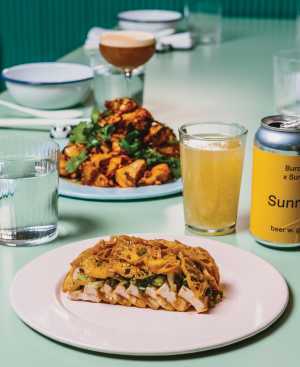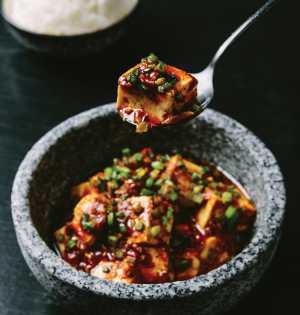Tofu is the chameleon of the culinary world. It’s just as likely to masquerade as meat as it is to moonlight as the base of a creamy sorbet or dressing. From jiggly cubes to skin-like sheets, tofu takes so many forms that it would be a tall order to list them all. It’s incredibly versatile, and, when seasoned right, is the furthest thing from a block of blandness.
Braden Chong, head chef at Mimi Chinese
Daniel Neuhaus
The soy-based product is ubiquitous in Asian cuisines and cultures. It’s also gained a reputation in the Western world as a popular plant-based protein for vegetarians and vegans.
Soy is an ancient ingredient, but don’t let its age fool you: It’s hip with the kids today and leading chefs are continually experimenting and innovating with tofu.
One of them is Braden Chong, head chef at the Michelin-recognized Mimi Chinese and a partner at the Bib-Gourmand-awarded Sunnys Chinese. He’s been eating tofu all his life thanks in part to his mom, who’d include it in soups and stews growing up.
Now, Chong serves two phenomenal plates of tofu at Sunnys: a soft appetizer topped with sweet soy sauce and fried Chinese doughnuts, and a spicy, juicy mapo tofu with dry-aged beef. Tofu is also available as an off-menu item at Mimi Chinese.
Chong breaks down everything we need to know about bean curd, from how it’s made, to the different types and the ways to make it delicious.
What is tofu?
Tofu, or bean curd, is coagulated soy milk often sold as gelatinous white bricks.
How is tofu produced?
“Soybeans are soaked, then ground into a paste and, using that water, boiled,” Chong explains. “The proteins are extracted, and you use a coagulant to set those proteins, much like the process to achieve soft cheese. You make the proteins into curds, and those curds are pressed into tofu.”
Where is tofu from?
As soybeans are one of the oldest crops in the world, bean curd has been around for thousands of years. Experts believe that it originated in Eastern Asia, likely in China. Over history, it’s become a staple in many Asian cuisines.

Soft tofu served at Sunnys Chinese
Daniel Neuhaus
What are the most common types of tofu?
Silken tofu
Ultra-soft and with the highest water content, silken tofu is excellent for blending into sauces, creams, dips or custards. Chong adds, “The softer the tofu, the more pleasant it is in its raw state. It's already cooked, so when I say raw, I mean served cold. If you wanted to, you could just eat silken tofu straight out of the packaging. It has an almost yogurt or pudding-like texture.”
Soft tofu
Regular, or soft, tofu has a bit more structural integrity than silken and is often included in soups and stews. It will break when handled, so it’s best used in dishes with minimal agitation required.
Firm tofu
Arguably the most versatile, firm tofu has been pressed before packaging. It can be pan-fried, deep-fried, baked or crumbled into an egg-scramble-type consistency. Extra-firm is very dense with a rubbery texture.
Other types of tofu
Tofu “skin,” or yuba, is a dried sheet of soy; tofu puffs are spongy pre-cooked balls that easily soak up moisture; egg tofu, which is made from soybeans and eggs, has a richer flavour. Pre-fried tofu is airy and spongy, and pre-seasoned tofu has been soaked in seasoning before being packaged.
Which kind of tofu is the most accessible?
“I would say soft tofu,” Chong recommends. “Silken tofu is very delicate and breaks easily. It's hard to work with. Firm tofu’s texture can come off a little dry or crumbly. Soft tofu is probably the best for those at the entry-level.”
What does tofu taste like?
“It depends on the type of tofu,” says Chong. “The softer and the fresher the tofu, the more delicate the flavour. I wouldn't say it's flavourless. It has a distinct flavour from the soybeans. It’s a little grassy and quite mild.”

A tofu dish at Michelin-recognized Mimi Chinese
Gabriel Li
How do you prepare tofu?
Stir-fry, bake, boil, fry, blend, marinate or eat cold — you name it, you can do it to tofu. “You can eat tofu in any part of the meal, paired with any flavour. It's a blank slate.” explains Chong. “It can be a nice little snack or side dish, or the main meal.” Chong says he's even turned tofu into a sweet, ice-cream-style dessert. “I wanted to keep it dairy-free and offer something interesting for diners. I wouldn’t say using tofu and soy milk in desserts is common in North America. But in Chinese culture, tofu is often eaten as a dessert — for example, as a hot pudding served with ginger syrup.”
What are some common misconceptions about tofu?
“Some people think tofu is gross or flavourless, or that it's just a terrible meat substitute,” Chong laughs. “I can see why people might have that idea, because if you're not eating tofu in traditional styles, it's possible it's not being prepared properly. If you're not seasoning your tofu well enough, it won’t have a strong flavour. You might be a little underwhelmed.”
What’s the best way to shop for tofu?
Chong suggests heading to Asian retail or grocery stores for the best bean curd. “It’ll be in the refrigerated section close to the dairy and eggs. They'll have several different tofu foods,” he says. “Experiment with a few recipes at home. See what works for you.”
